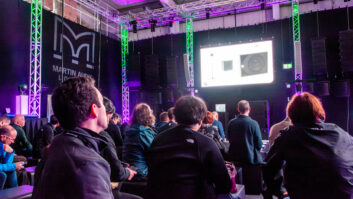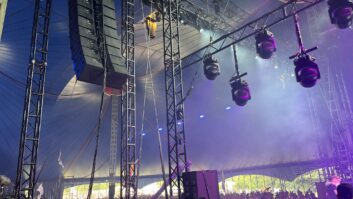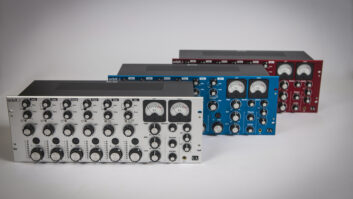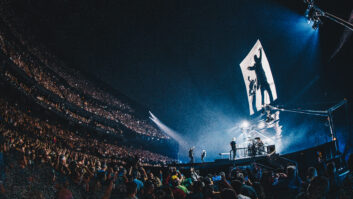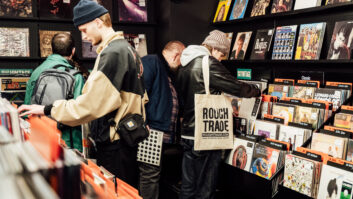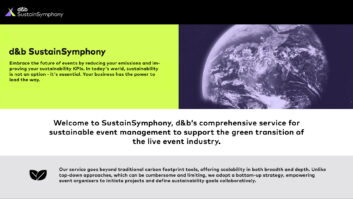A complex array of technologies, including FLUX:: software and JBL Professional loudspeakers, has come together to create Flyover in Chicago, an immersive experience which takes visitors on a simulated flight over Chicago’s most historic places.
Located in Chicago’s waterfront Navy Pier, the multi-sensory experience incorporates aerial shots captured by drones, as well as first-person narratives. The journey is shown on a 65ft spherical screen with flight motion seats engineered to swoop, dip and turn, giving guests the feeling of flight. The attraction transports 61 guests at a time, with complete sensory immersion using wind, mist and scents, as the fliers hang suspended.

Fliers witness the river, enjoy an aerial view of the Chicago Air and Water Show, pass over the Chicago Theatre and view a fireworks show at Navy Pier. The route was designed by Pursuit, the attractions and hospitality company behind the concept. At its Spring 2024 opening, it became the fourth of Flyover Attractions’ immersive indoor flying rides, after ones in Las Vegas; Vancouver, Canada; and Reykjavik, Iceland.
The spectacular nine-minute ride employs a large number of audio sources, which are controlled and dynamically spatialised by the audio object and Wave Field Synthesis features of FLUX:: SPAT Revolution immersive audio software, then played through a customised system of JBL loudspeakers in a nearly spherical configuration.
These technologies are supplemented with Crown amplifiers, BSS loudspeaker processing, and control systems from HARMAN Professional, who also supplied extensive support to the project.
The show has three parts. In part one, soft music plays in a video gallery while guests in the same time slot gather and watch images of suburbs and landmarks. In part two, visitors enter a round pre-show video chamber showing cityscapes and listen to a narrated short video that culminates in a performance by the Soul Children of Chicago. Finally, in part three, guests enter the theatre with the 65ft spherical screen, wind, mist, scents and moving seats.
The immersive theatre features a 10ft diameter, circular “lollipop” screen in the centre, plus an elliptical screen wrapping 360 degrees around the audience. Sound designer/mixer Tim Archer, of Masters Digital, programmed SPAT Revolution to control the soundtrack, which plays through a system designed by Austria-based Kraftwerk Living Technologies (KLT), who also designed the main flight ride audio system.
Speakers are placed behind the perforated screens, with each side of the venue featuring the same speaker configuration: eight JBL COL800 column loudspeakers inside the lollipop facing out, for a total of 16 cabinets, and six JBL AC18/26 compact two-way loudspeakers behind the wraparound screen, for a total of 12. Low-frequency support is provided by four ceiling-mounted JBL ASB6115 subwoofers.
A ring of 10 more AC18/26s mounted above the audience – five on each side of the room – acts as the primary source for presenting the music from composer Elliott Wheeler.
For the flight ride, guests are seated on one of three separate moving platforms which are vertically “stacked” in the room. Presenting realistic, well-balanced sound to every guest was the biggest challenge facing both Archer and KLT’s Philipp Hartl, responsible for sales/lead audio system design & optimisation.
With the platforms in constant motion, object audio was the only way to place a source and have each person hear it properly. Two guests viewing the same visual element from different platforms need separate mixes that accurately localise the sound for their positions, while the platforms continue to move.
Traditional multichannel mixes simply cannot accomplish this. For this reason, localisation in SPAT Revolution is not viewed in terms of routing sounds into loudspeakers, but, rather, sending them to “pan points” or virtual speakers to synthesise artificial wavefronts.
In his sound system design, Hartl faced the issue of trying to supply sound appropriately to three continuously moving platforms. He explained: “As a practical matter, it’s not possible to achieve the exact same coverage at every seat on each platform, so one of the really tricky things was to find a middle way to tune the speakers that minimised the amount of compromise made at any individual seat.”
Hartl used 34 JBL AM7215-series high power two-way loudspeakers, deployed in four different vertical layers, plus four JBL ASB7128 dual 18-inch subwoofers to furnish prodigious amounts of low-frequency effects. As in the pre-show theatre, SPAT Revolution rendered a different signal feed for each loudspeaker. To ensure clear rear localisation, a pair of JBL Control 23-1 ultracompact speakers is mounted on each seat back.
Once the content was generated and the system tuned, the presentation was implemented in a show control system for playback by Miami-based Smart Monkeys.
Bringing such a complex project to a successful conclusion involves plenty of tweaking and problem-solving. As a central contributor to the project, HARMAN gave close support to all the teams involved, with Flux’s Hugo Larin being deeply involved in the design and programming of the immersive audio.
Eric Sambell,global director of construction and entertainment, Flyover, said: “The technology has to be so good that it disappears, like it isn’t even there, so that guests enjoy a seamless experience from the moment they walk in the door to when they walk out afterwards. We don’t want guests thinking about the technology or where they are, we just want them to be present in what’s happening.”
